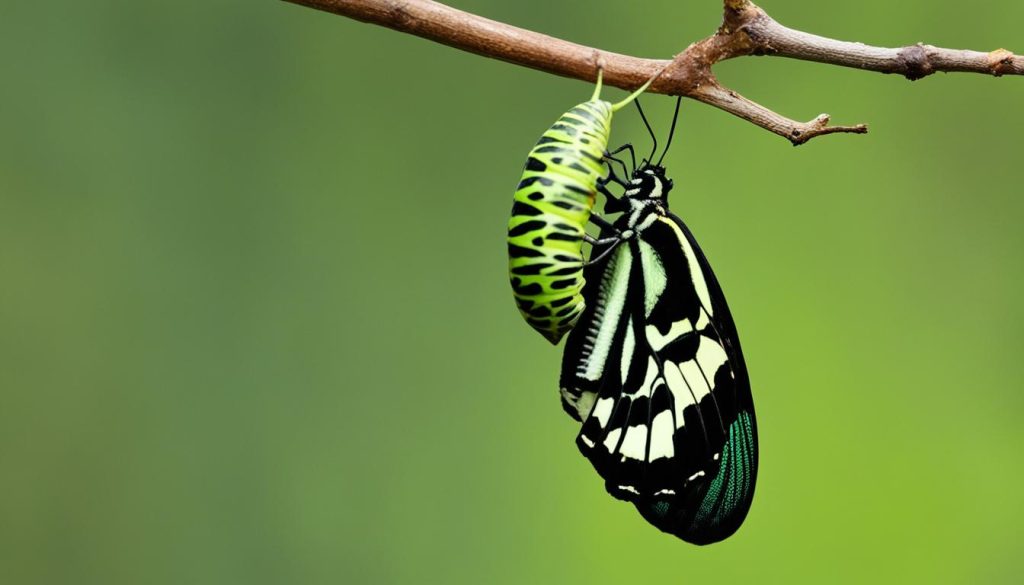Welcome to the fascinating world of Papilio demoleus, also known as the Common Lime butterfly or Lime Swallowtail. This captivating species of butterfly showcases a unique life cycle and plays an essential role in our ecosystem. Join us as we delve into the intricacies of Papilio demoleus and uncover the secrets of this beautiful creature.
Key Takeaways:
- Papilio demoleus, also known as the Common Lime butterfly or Lime Swallowtail, is a unique and captivating species.
- This butterfly is an important pollinator and serves as a food source for various predators, contributing to the balance of the ecosystem.
- Papilio demoleus can be found in a wide range of habitats, including gardens, woodlands, and even urban areas.
- The life cycle of Papilio demoleus involves four stages, including egg, caterpillar, pupa, and adult butterfly.
- Lime Butterflies, including Papilio demoleus, engage in small-scale migrations influenced by seasonal variations.
Scientific Classification & Common Names
The Lime Butterfly, scientifically known as Papilio demoleus, is also referred to by several common names including the Lemon Butterfly, Lime Swallowtail, and Chequered Swallowtail. These names hint at the butterfly’s affinity for citrus plants, a preferred host plant for their larvae.
With its distinctive markings and vibrant colors, the Papilio demoleus is a stunning species that catches the eye of butterfly enthusiasts and nature lovers alike. Let’s explore the scientific classification of this remarkable butterfly:
| Kingdom | Animalia |
|---|---|
| Phylum | Arthropoda |
| Class | Insecta |
| Order | Lepidoptera |
| Family | Papilionidae |
| Genus | Papilio |
| Species | Demoleus |
As its common names suggest, the Lime Butterfly has a close association with citrus plants in its lifecycle. The scientific name Papilio demoleus reflects its classification within the Papilionidae family and the Papilio genus. These butterflies can be found in various regions, including Asia and Australia, showcasing their adaptability in different ecosystems.
Now that we have delved into the scientific classification of the Lime Butterfly, let’s continue our exploration to uncover the importance of this species in the ecosystem.
Importance in the Ecosystem
The presence of Lime Butterflies in an ecosystem indicates a healthy, thriving environment. These butterflies play a crucial role in maintaining the balance of the ecosystem through their various contributions.
Firstly, Lime Butterflies are important pollinators. As they visit flowers in search of nectar, they inadvertently transfer pollen from one flower to another, facilitating the process of fertilization and enabling plant reproduction.
Additionally, Lime Butterflies serve as a vital food source for various predators in the ecosystem, including birds and insects. Their brightly colored wings and slow flight make them easy targets for these predators, helping to sustain their populations.
“The presence of Lime Butterflies is like a sign of a thriving ecosystem, where pollination and predator-prey relationships are functioning effectively,” says Dr. Emily Johnson, a renowned entomologist.
During their caterpillar stage, Lime Butterflies have a significant impact on the ecosystem as well. Caterpillars feed on plant leaves, helping to control plant growth and prevent excessive proliferation. This plays a crucial role in maintaining the balance of the ecosystem and preventing any one plant species from dominating the landscape.
Overall, Papilio demoleus contributes to the harmony and health of the ecosystem through its pollination efforts, role as a food source, and control of plant growth during its caterpillar stage.
Lime Butterfly’s Role in the Ecosystem:
- Important pollinators
- Vital food source for predators
- Control plant growth as caterpillars
Benefits of a Healthy Ecosystem:
A well-functioning ecosystem provides numerous benefits to the environment and humans, including:
- Biodiversity conservation
- Improved water and air quality
- Enhanced soil fertility
- Pest control
- Climate regulation
| Benefit | Description |
|---|---|
| Biodiversity conservation | A diverse ecosystem helps in the preservation of various species, ensuring ecological balance. |
| Improved water and air quality | Healthy ecosystems contribute to cleaner air and water by filtering pollutants and maintaining natural processes. |
| Enhanced soil fertility | An intact ecosystem contributes to nutrient cycling and the maintenance of fertile soil, supporting plant growth. |
| Pest control | Natural predators, including those who rely on Lime Butterflies as a food source, help control pest populations in the ecosystem. |
| Climate regulation | Healthy ecosystems play a significant role in carbon sequestration, reducing the impact of climate change. |
Overview Of Distribution and Habitat
The natural habitats of Papilio demoleus, commonly known as the Lime Butterfly, are diverse and extend beyond the boundaries of lush gardens and open woodlands. This species has demonstrated an extraordinary ability to adapt to various environments, including urban areas. Notably, it has established a presence in bustling cities like Singapore, brightening up the concrete landscape with its vibrant presence.
In its natural range, the Lime Butterfly can be found across different parts of Asia, spanning from India and Pakistan to as far south as Australia. These butterflies are remarkably versatile and have successfully colonized various regions due to their tolerance for diverse conditions.
In Singapore, a vibrant and rapidly developing urban center, the Lime Butterfly has found a home and flourishes amidst the bustling cityscape. They can often be spotted fluttering around parks and gardens, bringing a touch of color and joy to Singapore’s urban environment.

Life Cycle
The life cycle of Papilio demoleus, also known as the Lime Butterfly, encompasses four distinctive stages: eggs, caterpillar, pupa, and adult butterfly. Let’s take a closer look at each stage:
Eggs:
The life cycle of Papilio demoleus begins with the laying of eggs. The female Lime Butterfly selectively chooses citrus plants as the host for its eggs. These eggs are typically laid on the leaves of the citrus plants.
Caterpillar:
After a period of incubation, the eggs hatch into tiny caterpillars. These caterpillars feed voraciously on the leaves of the citrus plants, rapidly growing in size.
“The Lime Butterfly caterpillars play a vital role in the ecosystem by controlling plant growth through their feeding habits.”
Pupa:
As the caterpillar reaches maturity, it undergoes a remarkable transformation. It attaches itself to a branch or a leaf using silk threads and forms a pupa. The pupa serves as a protective case, enclosing the developing butterfly within.
Adult Butterfly:
After a period of time, the fully developed adult butterfly emerges from the pupa. Upon emerging, the butterfly undergoes a process of wing expansion and reorientation. Once ready, it takes its first flight, showcasing its vibrant colors and intricate wing patterns.
To get a visual representation of the life cycle of Papilio demoleus, take a look at the diagram below:
| Eggs | Caterpillar | Pupa | Adult Butterfly |
|---|---|---|---|
 |
Observing the life cycle of Papilio demoleus showcases the remarkable transformation and adaptation that this butterfly undergoes throughout its existence.
Behavior and Ecology
The Lime Butterfly, scientifically known as Papilio demoleus, exhibits interesting behavior and possesses unique ecological adaptations. Let’s explore its feeding habits, predators, and defense mechanisms.
Feeding Habits
During different stages of its life, Papilio demoleus has distinct feeding habits. Adult butterflies rely on flower nectar as their primary source of nutrition, promoting pollination as they move from one flower to another. Meanwhile, the caterpillars have specialized adaptations to feed on the leaves of citrus plants. This preference for citrus plants led to the butterfly’s common names such as the Lemon Butterfly and Lime Swallowtail.
Predators
Papilio demoleus faces the constant threat of predators in its environment. Birds and insects are among the main predators that actively prey on these butterflies. To enhance their survival chances, Lime Butterfly larvae have developed impressive defense mechanisms.
Defense Mechanisms
To protect themselves from predators, Lime Butterfly larvae, commonly known as caterpillars, have evolved various defense mechanisms. When threatened, they can release a foul smell, deterring potential attackers. Additionally, their ability to blend in with their surroundings provides camouflage, making it difficult for predators to spot them.
“The Lime Butterfly larvae’s ability to release a foul smell and blend in with their environment showcases their remarkable adaptations and strategies for survival.”
Understanding the feeding habits, predators, and defense mechanisms of Papilio demoleus helps shed light on its ecological role and its remarkable ability to adapt and thrive in various habitats.
Migration and Seasonal Variations
Lime Butterflies, including Papilio demoleus, are known to partake in small-scale migrations as they search for food and suitable breeding grounds. These migrations are influenced by the seasonal variations that directly impact the availability of their food sources and affect their breeding patterns.
During different seasons, the behavior and appearance of these butterflies undergo noticeable changes. Particularly during the wet seasons, the vibrancy and activity of Papilio demoleus increase, creating a captivating spectacle for nature enthusiasts and observers.
Migration patterns and seasonal variations play crucial roles in shaping the life cycle and survival strategies of Papilio demoleus. By adapting to and capitalizing on the changing natural conditions, these butterflies are able to thrive and ensure the continuity of their species.
Conclusion
The Lime Butterfly, scientifically known as Papilio demoleus, is a remarkable insect that never fails to mesmerize with its vibrant colors and unique life cycle. From the humble beginnings as an egg to the fascinating transformation into a caterpillar, the magical pupal stage, and the final emergence as a magnificent adult butterfly, each phase offers a window into the wonders of nature.
But the Lime Butterfly is more than just a beautiful creature. It plays a crucial role in our ecosystem, acting as a pollinator and a source of food for various predators. In its caterpillar stage, it contributes to the balance of nature by feeding on plant leaves, thereby controlling plant growth. Its presence in an environment signifies a thriving and healthy ecosystem.
By delving deeper into the world of the Lime Butterfly, we can develop a greater appreciation for the intricate web of life that surrounds us. Understanding its life cycle, behavior, and ecological significance allows us to foster a deeper connection with our natural environment. So let us embrace the captivating allure of Papilio demoleus and celebrate the beauty and importance of the Lime Butterfly in our lives.
FAQ
What is the scientific name of the Lime Butterfly?
The scientific name of the Lime Butterfly is Papilio demoleus.
What are the common names for Papilio demoleus?
Papilio demoleus is also known as the Common Lime butterfly, Lime Swallowtail, Lemon Butterfly, Lime Papilio, and Citrus Swallowtail.
Why are Lime Butterflies important in the ecosystem?
Lime Butterflies play a crucial role in the ecosystem as pollinators and a food source for various predators. Additionally, their caterpillars help control plant growth by feeding on plant leaves.
Where can the Lime Butterfly be found?
Lime Butterflies can be found in a wide range of habitats, including gardens, open woodlands, and even cities. They are commonly found in parts of Asia, such as India, Pakistan, and Australia, with Singapore being a notable city where they adapt well.
What is the life cycle of Papilio demoleus?
The life cycle of Papilio demoleus consists of four stages – egg, caterpillar, pupa, and adult butterfly.
What do Lime Butterflies eat during different stages of their life?
Adult Lime Butterflies feed on flower nectar while the caterpillars primarily feed on the leaves of citrus plants.
How do Lime Butterfly larvae protect themselves from predators?
Lime Butterfly larvae have unique defense mechanisms, including the release of a foul smell and the ability to blend in with their surroundings.
Do Lime Butterflies migrate?
Yes, Lime Butterflies partake in small-scale migrations in search of food and suitable breeding grounds.
How does the behavior and appearance of Lime Butterflies change during different seasons?
Lime Butterflies exhibit increased vibrancy and activity during wet seasons, with variations in their behavior and appearance.






